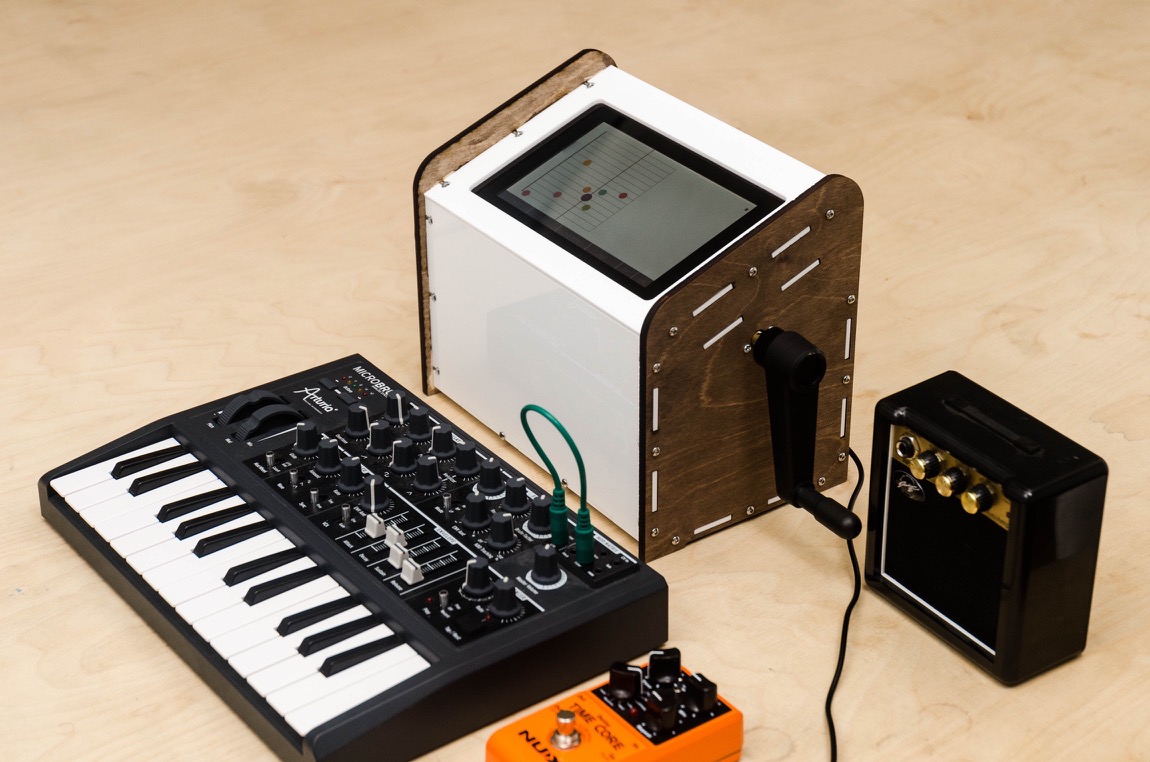Twinklr
A modern music box
Twinklr is a modern music box: an electronic instrument controlled with a crank handle and a touchscreen. I developed it with composer Richard Birkin, initially with funding from D-Lab, and subsequently with funding from MV Works
Twinklr’s origins were with Richard. Having made compositions for music boxes previously, he was interested in what a touchscreen on a music box might feel like. Our first version, funded by D-Lab and built around a tablet computer, was a proof of concept.

The MV Works budget allowed us to really explore the concept in depth. We explored in a few different directions. We added richer functionality to the software, going beyond simple emulation of a music box and instead exploring things only a digital music box could do - polyphony, scale quantisation, and even controlling other electronic instruments over MIDI. We altered the platform the instrument was based upon: instead of being a tablet computer in a box, an operating system running software, we’d use a Raspberry Pi and make the object feel like it was an instrument in its own right. And we refreshed both the enclosure and the approach to making it: rather than something built by hand, we’d make something using computer-aided design and computer-controlled manufacture techniques.
These last developments also addressed something that MV Works were interested in: repeatability and commercial viability. I knew that we weren’t going to be designing a retail product per se - but previously, in the version we built for D-Lab, the answer to “can you build another Twinklr?“ was “not easily“. Now the answer was a genuine yes: all it took was cutting another case, flashing an SD card for an off-the-shelf single board computer, and assembling the product from parts. By considering repeatbility, we were understanding what it’d take to make more of them. We quietly took note of every time somebody asked us ‘how much is it?‘ and gauged their reactions when I told them a rough price.
Twinklr is entirely open source. The schematics, CAD plans for making the case, and software are all available at the project’s Github organisation. It is complex, but possible, for anyone else to build their own. It’s built on top of so many open-source projects - Linux, Processing - that it only felt right to make it an open-source product too. So whilst it’s perhaps more symbolic, than viable, that it’s an open source project, it’s important nontheless.
I kept a diary on Tumblr during the six months of making the music box, and the final results are documented at the Twinklr website.
Instruments and Instrumentiness
From a design perspective, Twinklr let me explore a developing interest in instrument making, and the term I came to call Instrumentiness. What made something an instrument? What were better practices in its design? The loose conclusions that drove the project were something along these lines:
- Instruments allow for mastery. You may be able to do something with them immediately, or not - depending on how difficult they are to learn - but there should always be a way to improve and master it.
- Instruments allow for exchange. If I say I play an x, and you also play an x, I should be able to give you my x and you could play it. It might not be quite the same as yours, but you’d feel familiar. (This is why a ‘laptop’ is never an instrument, for me - a particular combination of software and hardware, however, might be)
- Instruments allow for exploration. Or: you can play them wrong. Consider Jimi Hendrix with his guitar behind his head, strung upside down; not what you’re meant to do, but creatively expressive nontheless. Or: consider striking an instrument meant to be bowed, bowing a cymbal; also valid forms of expression.
- Instruments allow for expression. Different performers will sound different on them, play them differently, have their own distinct techniques.
- Instruments require a player. An instrument requires a person (or persons) to play it. On its own, it doesn’t do a lot.
- Instruments allow for customisation. They may start the same, but they are customised and shaped according to the player.
Twinklr does some of these well; some of these less so; but these were all ideas developed in the process. And, needless to say, those ideas go beyond this short bullet-pointed list; they’re ideas that continue to sit with me.
Tools and techniques
Twinklr was a project on which I learned and refined new tools and techniques. I taught myself enough CAD for manufacture - designing objects in 3D around existing parts of known size, and ensuring that the panels of that object could be laser-cut and assembled with bolts and screws. I refined my electronics skills, building custom PCBs designed in EAGLE. And I gained significantly more experience in Processing, our eventual software platform (after the browser-based prototypes proved unperformant on the Raspberry Pi).
Developments
For now, Twinklr is over. Perhaps it’ll be resuscitated in other forms. But its ideas live on with me, and many of the techniques and skills I learned in the process of making it have had other impacts. A lot of the skills - from running hardware projects through to instrument design - have made my work with the Foxfield Instruments products possible. There are still elements of Twinklr I want to explore in the future. We’ll see what comes of it.